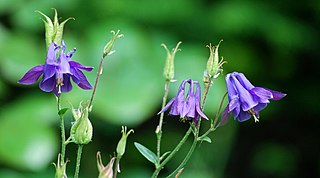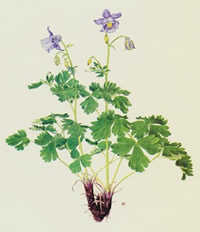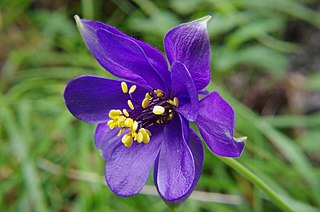
Aquilegia is a genus of about 130 species of perennial plants that are found in meadows, woodlands, and at higher elevations throughout the Northern Hemisphere, known for the spurred petals of their flowers.

Aquilegia grata is a perennial species of flowering plant in the family Ranunculaceae, endemic to the northwestern Balkans.

Aquilegia barbaricina, common name Barbaricina columbine, is a perennial species of flowering plant in the family Ranunculaceae. It is endemic to Italy, occurring only on the island of Sardinia.

Aquilegia nuragica, commonly called Nuragica columbine, is a perennial flowering plant in the family Ranunculaceae. It is endemic to Italy, in a single canyon in the Supramonte mountain range on the island of Sardinia.

Aquilegia alpina, the alpine columbine or breath of God, is a perennial species of flowering plant in the family Ranunculaceae, native to the western and central Alps.

Aquilegia olympica is a perennial flowering plant in the family Ranunculaceae, native to Turkey, Iran, and the Caucasus.

Aquilegia ottonis is a perennial flowering plant in the family Ranunculaceae, endemic to Greece.

Aquilegia confusa is a partially accepted species of flowering plant of the genus Aquilegia (columbines) in the family Ranunculaceae that is endemic to the eastern and southern European Alps in Switzerland and Italy. The entirety of the plant, particularly its seeds, are toxic to humans.

Aquilegia champagnatii is a perennial species of flowering plant in the family Ranunculaceae, native to Italy.

Aquilegia kitaibelii is a perennial species of plant in the family Ranunculaceae, native to Croatia, Bosnia and Herzegovina, and possibly Slovenia.
Aquilegia aragonensis is a perennial flowering plant in the family Ranunculaceae, endemic to northern Spain.
Aquilegia ballii is a perennial flowering plant in the family Ranunculaceae, endemic to Morocco.

Aquilegia barykinae is a perennial flowering plant in the family Ranunculaceae, endemic to the Russian Far East. The species was first described in 2014. Its flowers are lilac-blue.

Aquilegia cazorlensis is a perennial flowering plant in the family Ranunculaceae, endemic to southeastern Spain.

Aquilegia cossoniana is a perennial flowering plant in the family Ranunculaceae, native to the Atlas Mountains in northwestern Africa.
Aquilegia cremnophila is a perennial flowering plant in the family Ranunculaceae, endemic to Sardinia.
Aquilegia × cottia is a perennial flowering plant in the family Ranunculaceae, native to the Alps of Italy and Austria. It is a natural hybrid of Aquilegia alpina and Aquilegia atrata.

Aquilegia daingolica is a perennial flowering plant in the family Ranunculaceae, endemic to Mongolia. The plant's flowers are blue or violet-blue.
Aquilegia dichroa is a perennial flowering plant in the family Ranunculaceae, native to Portugal and northwestern Spain.

Aquilegia dumeticola is a perennial flowering plant in the family Ranunculaceae, native to southeastern Europe.














